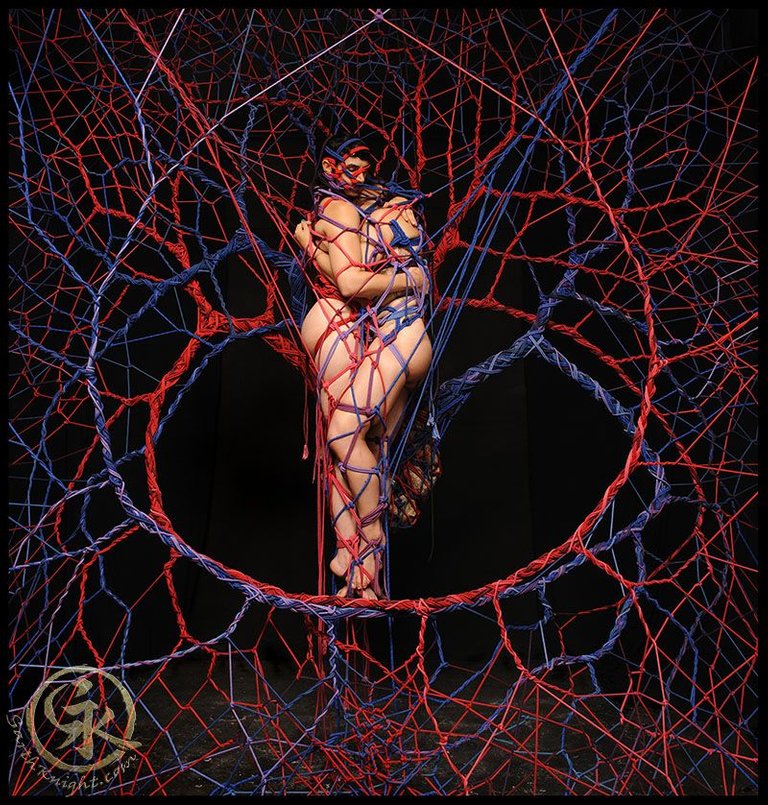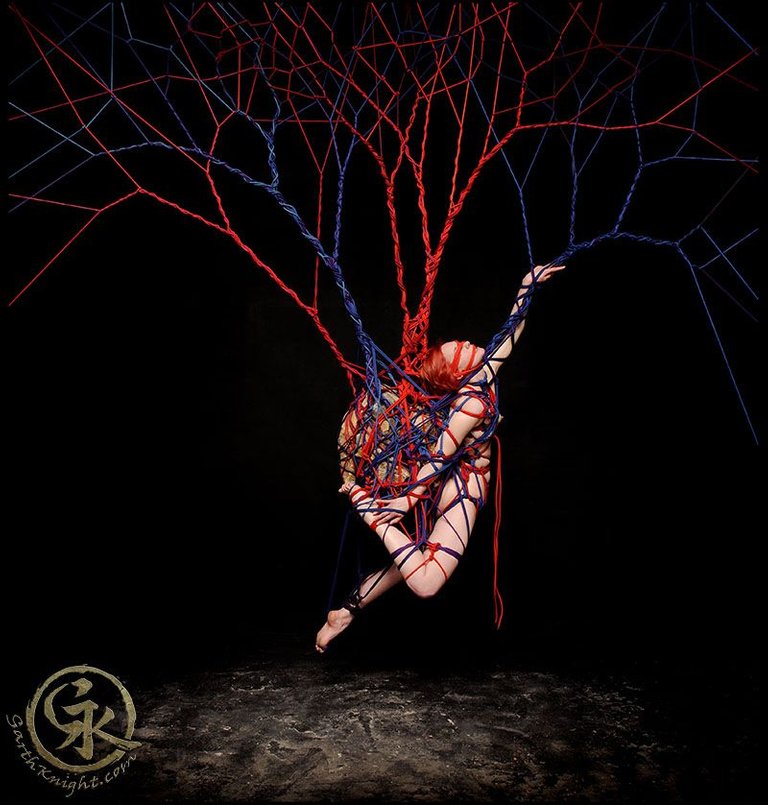Over the ages, the human body has been represented in multiple formats in the art world. Historically, artists portrayed culturally “perfect” depictions of the human form. Jean Robertson and Craig McDaniel, the authors of “Themes of Contemporary Art,” have a whole chapter dedicated to the way artists today make “art that is focused directly on the body and what the body means.” The way artists have been referencing the form of the body has been constantly evolving. Artists have expanded their repertoire from painting, photographing, and sculpting the body as subject, to using bodies in live performance of their art.
Garth Knight creates, performs, and photographs his unique explorations of the human body. Though he has an individual take on the concept, the closest descriptor of his art is “shibari.” The current techniques of shibari have a history that stems from ancient Japanese samurai. As Knight has said, “The word ‘shibari’ itself simply means to tie.” Shibari, as an ancient technique of prisoner bondage, however, has little in common with the way it is performed now.
Today, those who practice shibari, or kinbaku as it is sometimes called, typically utilize the artistry and symmetry of the rope for erotic purposes.
“Shibari is a form of BDSM [bondage, domination, sadism, and masochism]. The term is a Japanese word that means to tie or to bind. It is used in Japan to describe the artful use of twine to tie objects or packages. It involves the use of thin pieces of rope to bind the submissive partner in ways that are meant not only to be artistically beautiful, but also to heighten the sensation of orgasm.”
When engaging in “rope play,” depending on the preset rules agreed to by each participant, there are different obligations expected from the person doing the tying than from the one being dressed in rope. The person tying is typically called the “top” and the one submitting to being tied is usually the “bottom.” Both of their bodies are actively engaged in the act (which may or may not be done for the purposes of sexual gratification). The aesthetic of the scene is set by both the visual aspect of the beauty of the subject and rope work, but also from the mood and ambiance caused through the exchange of power and trust.

Figure 1. Knight, Garth. 2013. Blood Consciousness 8 (Francesca and Betty). Garth Knight Portfolio. http://www.garthknight.com/portfolios/2013bloodconsciousness/index.html.
In “Themes of Contemporary Art,” the authors speak of the way eroticism, especially that of women, has been becoming more prevalent in the art world. Shibari, especially with its background in the sub-culture of BDSM, is something not normally thought of as a “fine art,” but in the wake of Postmodernism art and thought, there is room for the works of these artists to be recognized as such. Robertson and McDaniel say, “Artists who represent female eroticism in ways that are simultaneously attractive and alienating, arousing and anxiety producing, may deliberately reflect the confusion about sexuality in contemporary culture.” In other words, this is art that is meant to make the viewer contemplate their own internal presuppositions. As an art form that highlights the body, it is giving “visual form to previously taboo aspects of sexuality.”
Garth Knight began his art career when he graduated with a diploma in photography, in 1999. A chance encounter with a BDSM performance, where the entertainers were utilizing rope, inspired him to take up the art form for himself. Knight, saying, “I have always had a strong affinity with line and had enjoyed playing with rope for practical purposes. In 1999, when I first saw a person being beautifully bound, it was like a revelation.” He now combines his background in photography with his love of sculptural shibari rope work.
Through his own study of the art, he has been able to blend his own unique style into what can be a very prescriptive form of sexual expression. He says,
I just started playing around and for many years I was just teaching myself, developing my own style and stumbling around in the dark. When I became aware of kinbaku I was very attracted to it and started incorporating elements of it into my style, though I have always been very careful to make this symbiosis influential rather than a replication.
The forms he creates go far beyond what is required to thoroughly bind a person. His sculpture combines components of the natural with the very manipulated features of the rope. Though the artistic nature of rope work is typically noticed and appreciated, it a thing that is not focused on in the BDSM sphere, where the main goal is the bondage. Garth Knight’s work shows that he is first and foremost an artist, who has found an area of work that attracts him on multiple levels.
Knight’s Blood Consciousness series is some of the most colorful of his rope works. The series is made to resemble veins and shaped like both an anatomical and representational heart shape. The 8th photograph in the series, Francesca and Betty (see Figure 1), is the conclusion photograph of the series. The bound couple in the center, one tied in blue and one in red, intertwined with blue and red twisted rope veins are suspended in mid-air, arms wrapped around each other’s chest, embracing tightly. There is a sense of intimacy, comfort, and security in the pose, felt by even the viewer.

Figure 2. Knight, Garth. 2013. Blood Consciousness 1 (Jessie). Garth Knight. Accessed 04 2018. http://www.garthknight.com/portfolios/2013bloodconsciousness/pages/01.html.
When looking at the first of the series, Jessie (see Figure 2), compared to the last, the progression is apparent, partially signified by the minimalism of this photo’s rope elements. The model looks weightless. Her body is closely wrapped around the centerpiece of bound rocks. She is tied with both red and blue rope, her shape forming the first heart of the series. Her light skin contrasts the rope and the black background dramatically. She may be solitary, but she is not alone—she is one with the rope. The air of her presence is calm and contented.
Knight says each photo shoot can take hours and, “The entire series takes many days to produce, normally stretched out over weeks or months.” Each of the series shows further development of the sculpture, with every scene containing different models, positioned in different configurations. Though each image is an extension of the last, individually they tell their own stories through the pose, tie, and amount of detail obtained by layering the rope.
Knight’s technique of shibari rope suspension is distinctive and striking. The scenes he creates follow in the footsteps of artists like Robert Mapplethorpe, by broadening the limits of the fine art world and introducing the collector to the realms of sub-culture sexuality. In displaying these works in the gallery context, the curators are helping to normalize those in the “scene” who have felt that they were outcasts. This is the power of art.
Bibliography
- "Garth Knight Artworks." .M CONTEMPORARY. .M CONTEMPORARY. Accessed 04 2018. https://mcontemp.com/wp-content/uploads/2017/08/GarthKnight_Artworks_NP.pdf.
Knight, Garth. 2013. "Blood Consciousness 1 (Jessie)." Garth Knight. Accessed 04 2018. http://www.garthknight.com/portfolios/2013bloodconsciousness/pages/01.html.
Knight, Garth. 2013. "Blood Consciousness 8 (Francesca and Betty)." Garth Knight Portfolio. http://www.garthknight.com/portfolios/2013bloodconsciousness/index.html.
McIntyre, Colette. 2017. Meet the Photographer Using Rope Bondage to Create Incredible Art. Konbini. Accessed 03 2018. http://www.konbini.com/us/inspiration/artist-garth-knight-rope-bondage/.
Robertson, Jean, and Craig McDaniel. 2013. Themes of Contemporary Art. Vol. 3rd Edition. New York, NY: Oxford University Press. 77-94.
Roma, Paolo, Floriana Pazzelli, Maurizio Pompili, Paolo Girardi, and Stefano Ferracuti. 2013. "Shibari: Double hanging during consensual sexual asphyxia." Archives Of Sexual Behavior 42, no. 5: 895-900. PsycINFO, EBSCOhost (accessed April 29, 2018).
Long time fan of his work here... beautiful stuff...
<3 Ditto. I just wrote this for my art history class and did a presentation on his work. AND...I got to use my psychology references for it, too! Yeah, pretty happy with this short little thing.
Red and blue were always my favorite colors.
Primary and contrasting. Yeah, they are good.
Opposite ends of the spectrum!
When I presented in class, I made sure to comment on the safety procedures and knowledge of anatomy required for rope bondage.
Congratulations @puddles! You have completed some achievement on Steemit and have been rewarded with new badge(s) :
Click on any badge to view your own Board of Honor on SteemitBoard.
To support your work, I also upvoted your post!
For more information about SteemitBoard, click here
If you no longer want to receive notifications, reply to this comment with the word
STOPCongratulations @puddles! You received a personal award!
Happy Birthday! - You are on the Steem blockchain for 1 year!
Click here to view your Board
Congratulations @puddles! You received a personal award!
You can view your badges on your Steem Board and compare to others on the Steem Ranking
Vote for @Steemitboard as a witness to get one more award and increased upvotes!